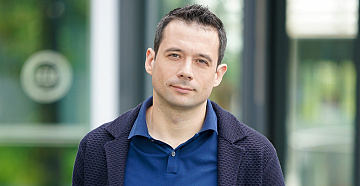Technology challenges of tomorrow and STEP LOGIC response
Technology challenges of tomorrow and STEP LOGIC response
During the 27 years in business, STEP LOGIC has never rested on its laurels. The integrator still sees ways to develop its existing competencies and is prepared to master new technologies. Roman Ostapchuk, Deputy Head of Technical Development at STEP LOGIC sheds light on promising market innovations and the company's initiatives in those areas, for the readers of ICT-Online.ru.
High-speed networks on a global scale
Amidst the widespread and well-deserved attention to applied technologies, augmented reality, robotic process automation, Industrial Internet of Things and other technologies, I would like to stress the role of basic technologies that will determine our foreseeable future. I am talking about global high-speed networks – 5G and low-earth-orbit satellite communication.
All the advanced applied technologies will soon experience problems with implementation due to a lack of high-speed networks, connection with minimum delays, and a globally available network. Obviously, all of the existing solutions related to wired and wireless networks are economically viable and are being used successfully. But with the growing requirements to a large bandwidth, low delay levels, and – especially important for Russia's enormous territory – geographic availability of the network, the limitations of existing technologies will be more and more apparent, and will keep restraining companies in bringing their ambitions to life.
Wide area high-speed wireless network
I also believe that wide area high-speed wireless networks with high-quality characteristics will become crucial in the near future. Wired solutions, local wireless networks and LPWA solutions are unable to satisfy this task in full. Using combinations of existing technologies comes with significant limitations with regards to scalability, and leads to well-known difficulties and increased operating costs for numerous technological solutions.
Low-frequency mobile solutions and low-earth-orbit satellite communication can also become promising and universal technological implementations of the specified tasks. Creating geographically dispersed cellular networks that support applications for distributed computing, robotic automation and augmented reality would offer practical support to plans on modernisation of Russia's manufacturing infrastructure.
Augmented and virtual reality
I believe it's reasonable to expect explosive growth in practical interest to augmented and virtual reality technologies. The obvious attractiveness and prestige of these technologies in the eyes of end users have led to inflated expectations associated with them. Significant technological challenges have also had a negative impact here. This includes the above-mentioned demand for broadband wireless network access. But solutions are being continuously improved, and installation and maintenance costs for equipment and software systems are being optimised. The day when we achieve the critical threshold is approaching, and these technologies will soon become an integral part of our routines, both at work and in everyday life.
STEP LOGIC innovations – up to the task
STEP LOGIC has always demonstrated a strong network expertise; we have a track record in implementing network projects of any scale, both at the level of enterprise solutions and for federal network operators. Moreover, as a complex system integrator STEP LOGIC is prepared to not only provide its expertise for implementing promising network solutions for our customers, but also to expand the area of application of promising network solutions for implementing their commercial business initiatives. We all know that right now satellite communication prospects largely depend on the government's regulations. But when it comes to wireless network technology, STEP LOGIC is already working through Private LTE and 5G MEC cases.
There is always a lack of wireless solutions professionals, especially for working with advanced technologes, so we actively invest in developing competencies required in those areas, in establishing a closer cooperation with leading global vendors, and in supporting forward-thinking Russian equipment manufacturers.
Another development vector of our company is organising well-coordinated project work between our internal centres of technological competencies and client teams, with an aim to more fully promote innovative solutions for tackling existing tasks of our customers.
Advanced technology in STEP LOGIC projects
With regards to technologies I've mentioned above, we are actively working on projects that use existing wireless network technologies of various purposes (LPWA, LTE, WiFi, RFID, and many others). We are excited to welcome the long-awaited commercially available WiFi 6 equipment, and projects using it will be moving to the implementation stage in the near future. In addition to that, we can also see the demand for and are already trying to map out the cost-effectiveness of using Private LTE/5G technologies and satellite communication for our commercial customers.
STEP LOGIC actively invests in developing its expertise in 3D modelling, including but not limited to Building Information Modelling technologies. This allows us to not only effectively solve practical tasks of our customers at the planning stage, but also to simulate different real-life scenarios on the very first stages of promising projects.
For instance, the ability of our customers to "walk around" several options of the planned corporate DPC as early as at the stage of budget planning and preliminary design is becoming a standard practice. Due to being highly informative, this kind of visualisation takes our interaction with the customer's departments to a whole other level. The period for making changes, accounting for the cross impact of the changes on connected systems, specifying cost parameters and searching for the most cost-effective solution – it all becomes significantly optimised with 3D modelling technologies. It also helps us conduct a transition from a simulation model to a design model, and later on – to a digital operating model, which is valuable for complex projects of our customers.
By Roman Ostapchuk, Deputy Head of Technical Development at STEP LOGIC
Source: ICT-Online.ru
